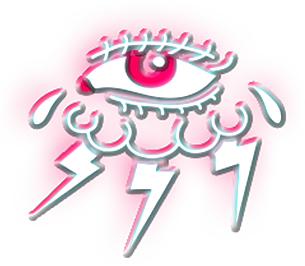
Kermes is a red dye
Kermes is a red dye derived from the dried bodies of the females of a scale insect in the genus Kermes, primarily Kermes vermilioThe Kermes insects are native in the Mediterranean region and are parasites living on the sap of the host plant, the Kermes oak (Quercus coccifera) and the Palestine oak (Quercus calliprinos). These insects were used as a red dye since antiquity by the ancient Egyptians, Mesopotamians, Indians, Greeks, Romans, and Iranians. The kermes dye is a rich red, a crimson. It has good colour fastness in silk and wool. It was much esteemed in the medieval era for dyeing silk and wool, particularly scarlet cloth. Post-medievally it was replaced by other red dyes, starting with cochineal. Amar, Z.; Gottlieb, Hugo; Varshavsky, Lucy; Iluz, David (2005). “The Scarlet Dye of the Holy Land”. BioScience. American Institute of Biological Sciences. 55 (12): 1080–1083. doi:10.1641/0006-3568(2005)055[1080:TSDOTH]2.0.CO;2, p. 1081

History
Kermes dye is of ancient origin; jars of kermes have been found in a Neolithic cave-burial at Adaouste, northeast of Aix-en-Provence. The early Egyptians made use of the kermes dye. Barber, E. J. W. (1991). Prehistoric Textiles. Princeton University Press. ISBN 0-691-00224-X., pp. 230–231. Encyclopaedia Britannica, s.v. Kermes insect and dye
In the Middle Ages, rich crimson and scarlet silks dyed with kermes in the new silk–weaving centers of Italy and Sicily exceeded the legendary Tyrian purple “in status and desirability”. The dyestuff was called “grain” (grana) in all Western European languages because the desiccated eggs resembled fine grains of wheat or sand, and textiles dyed with kermes were described as dyed in the grain. Woollens were frequently dyed blue with woad before spinning and weaving, and then piece-dyed in kermes, producing a wide range colours from blacks and grays through browns, murreys, purples, and sanguines. One source dated to the 12th-century notes that kermes dye adheres best to animal-based fibers (e.g. wool, silk, etc.), rather than to plant-based fibers (e.g. cotton, linen, etc.). Schoeser, Mary (2007). Silk. Yale University Press. ISBN 0-300-11741-8, p. 118. Munro, John H. “The Anti-Red Shift – To the Dark Side: Colour Changes in Flemish Luxury Woollens, 1300–1500“. In Netherton, Robin; Gale R. Owen-Crocker, eds. (2007). Medieval Clothing and Textiles. Vol. 3. Boydell Press. ISBN 978-1-84383-291-1., pp. 56–57. Munro, John H. “Medieval Woollens: Textiles, Technology, and Organisation“. Jenkins, David, ed. (2003). The Cambridge History of Western Textiles. Cambridge University Press. ISBN 0-521-34107-8., pp. 214–215. Amar, Z. (2007). Serri, Yaron (ed.). Tracking the scarlet dye of the Holy Land (Be-ʻiḳvot tolaʻat ha-shani ha-Erets-Yiśreʼelit) (in Hebrew). Neṿeh Tsuf (Modi’in). ISBN 965-90818-2-0. OCLC 645876294, pp. 34, 52 (citing Ibn al-Baitar and others).
By the 14th and early 15th century, brilliant full grain pure kermes scarlet was “by far the most esteemed, most regal” colour for luxury woollen textiles in the Low Countries, England, France, Spain and Italy. Munro, John H. “The Anti-Red Shift – To the Dark Side: Colour Changes in Flemish Luxury Woollens, 1300–1500“. In Netherton & Owens-Crocker (2007), pp. 56–57.
Following the Spanish conquest of the Aztec Empire, Mexican cochineal, which produced a stronger dye and could thus be used in smaller quantities, replaced kermes dyes in general use in Europe. Schoeser, Mary (2007). Silk. Yale University Press. ISBN 0-300-11741-8., pp. 121, 248 Barber, E. J. W. (1991). Prehistoric Textiles. Princeton University Press. ISBN 0-691-00224-X., p. 55.
Etymology
Kermes ultimately derives from the Sanskrit word कृमिज or kṛmija meaning “worm-made“. This was adopted into Persian and later Arabic as قرمز qermez. The modern English word kermes was borrowed from the French term kermès. Company, Houghton Mifflin Harcourt Publishing. “The American Heritage Dictionary entry: Kermes“. www.ahdictionary.com. Retrieved 2021-08-16.
c. 1600, “shield louse (Coccus ilicis) that yields a red dye” (1590s of the tree on which the insects live), from Medieval Latin cremesinus (also source of French kermès, Italian chermes, Spanish carmes), from Arabic qirmiz “kermes,” from Sanskrit krmi-ja a compound meaning “(red dye) produced by a worm.” Harper, Douglas. “Etymology of kermes.” Online Etymology Dictionary, https://www.etymonline.com/word/kermes. Accessed 4 January, 2023.
The Sanskrit compound is krmih “worm” (from PIE root *kwrmi- “worm,” source also of Lithuanian kirmis, Old Irish cruim, Albanian krimp “worm“) + -ja- “produced” (from PIE root *gene- “give birth, beget”). The insect lives in the Levant and southern Europe on a species of small evergreen oak (kermes oak) and in ancient Europe were the main source of red and scarlet dye. The dye is prepared from the dried bodies of pregnant females, which alive resemble small roundish grains about the size of peas and cling immobile to the tree on which they live. From this fact kermes dye was, for a long time, mistaken as being from a seed or excrescence of the tree, and the word for it in Greek was kokkos, literally “a grain, seed” (see cocco-). This was passed to Latin as coccum, coccus “berry [sic] yielding scarlet dye,” in late use “scarlet color, scarlet garment.” Harper, Douglas. “Etymology of kermes.” Online Etymology Dictionary, https://www.etymonline.com/word/kermes. Accessed 4 January, 2023.
So important was kermes (coccus) as a commercial source of scarlet dye that derivatives of the name for it have displaced the original word for “red” in many languages, such as Welsh coch (from Latin), Modern Greek kokkinos. Also compare Russian čcermnyj “purple-red,” Old Church Slavonic čruminu. Compare also crimson (n.). Kermes dyes have been found in burial wrappings in Anglo-Scandinavian York, but the use of kermes dyes seems to have been lost in Europe from the Dark Ages until early 15c. It fell out of use again with the introduction of cochineal (the word for which itself might be from coccus) from the New World. Harper, Douglas. “Etymology of kermes.” Online Etymology Dictionary, https://www.etymonline.com/word/kermes. Accessed 4 January, 2023.
- See also: crimson. cochineal, carmine. coccus. engrain. grain. vermeil
cocco-
word-forming element meaning “berry, seed,” or something shaped like them, from Latinized form of Greek kokkos “a grain, a seed,“ especially “kermes-berry, gall of the kermes oak” (actually an insect), which yields scarlet dye, a word of unknown origin, perhaps from a non-Greek source.
Cloths dyed with kermes are of a deep red colour; and though much inferior in brilliancy to the scarlet cloths dyed with real Mexican cochineal, they retain the colour better and are less liable to stain. The tapestries of Brussels and other parts of Flanders, which have scarcely lost any thing of their original brilliancy, even after a lapse of 200 years, were all dyed with kermes.
[W.T. Brande, “Dictionary of Science, Literature, & Art,” London, 1842]
The biblical scarlet (tolaʻat šanī)
In the Bible, scarlet was one of three principal pigments used in the Temple curtain, appurtenances, and sacred vestments. In some cases scarlet wool threads were woven together with threads of other colors; elsewhere a purely scarlet fabric was required. In addition, scarlet-dyed yarn was thrown as an adjunct into the burning ashes of the Red heifer, and was used as an adjunct in the purification ritual of lepers who had been healed. Amar, Z. (2007). Serri, Yaron (ed.). Tracking the scarlet dye of the Holy Land (Be-ʻiḳvot tolaʻat ha-shani ha-Erets-Yiśreʼelit) (in Hebrew). Neṿeh Tsuf (Modi’in). ISBN 965-90818-2-0, p. 21. Cf. Exodus 26:31; 2 Chronicles 3:14. Cf. Numbers 4:8. Cf. Exodus 28:5–6; Exodus 39:1. Exodus 26:31; Exodus 28:6. Numbers 4:8. Cf. Numbers 19:6. Cf. Leviticus 14:4
The English word for the biblical “scarlet” (Exodus 25:4, etc.) is a literal translation from the Septuagint (Koinē Greek: κόκκινον = kókkinon, meaning “scarlet”). The original Hebrew text (tola’at shani) translates to “scarlet worm”, indicating that the scarlet color is derived from an animal, a requirement which was formalized in the Jerusalem Talmud (Kila’im 9:1 [32a]). This animal was known in the Roman world as grani coccum = “the grain of the scarlet yarn.” Amar, Z. (2007). Serri, Yaron (ed.). Tracking the scarlet dye of the Holy Land (Be-ʻiḳvot tolaʻat ha-shani ha-Erets-Yiśreʼelit) (in Hebrew). Neṿeh Tsuf (Modi’in). ISBN 965-90818-2-0, pp. 15–20. Amar (2007), p. 28, citing Pliny the Elder, Natural History (XXII.3.3.), and which Pliny says was used to dye the military costumes of their generals.
While production of the crimson or scarlet dye from the kermes scale insect had, traditionally, been an art preserved with medieval dyers, the practice seemed to have been lost for many centuries. Late exponents of Jewish law were baffled by the Tosefta‘s ruling that tola’at shani (scarlet colored ritual wool) may only be made from the tola’at (worm-like aphid) which lives in the mountainous regions. The dye’s crimson or scarlet-orange tinge is alluded to in an early rabbinic source, Pesikta Rabbati, where tola’at shani is said to be “neither red, nor green,” but of an intermediate color. Biblical exegete Saadia Gaon (882–942) wrote that the scarlet colored fabric was qirmiz (Arabic: قرمز), derived from the kermes insect and which produced a color ranging from Venetian scarlet to crimson. According to Saadia, the dye was applied to silk yarns. A rare 10th-century Arabic document was retrieved by Zohar Amar, from which he was able to reproduce the dye extract, using antique methods. Amar, Z.; Gottlieb, Hugo; Varshavsky, Lucy; Iluz, David (2005). “The Scarlet Dye of the Holy Land”. BioScience. American Institute of Biological Sciences. 55 (12): 1080–1083. doi:10.1641/0006-3568(2005)055[1080:TSDOTH]2.0.CO;2, p. 1080. Bleich, J. David (1967). “A Review of Halakhic Literature Pertaining to the Reinstitution of the Sacrificial Order“. Tradition: A Journal of Orthodox Jewish Thought. Rabbinical Council of America (RCA). 9 (3): 103–124. JSTOR 23256821, p. 114. Cf. Exodus 39:29. Cf. Tosefta Menachot 9:6 [16]–7 [17], where it states: “Shani tola’at (scarlet producing worm) comes from the tola’at (worm-like aphid) that is in the mountains. Had it been brought from aught other than the tola’at that is in the mountains, it is invalid.” [Tosefta with the commentary Ḥasdei David, David Pardo (ed.), vol. 6 (Kodashim – I), Vagshal: Jerusalem 1994, p. 331 (s.v. Menachot 9:6)]. Pesikta Rabbati (n.d.). Meir Ish Shalom of Vienna (ed.). Midrash Pesikta Rabbati (in Hebrew). Israel: not identified. p. 98b (chapter 20 – end, section Matan Torah). OCLC 249274973. (reprinted from 1880 edition): “[When Moses went up on high]… he saw a troop of angels that were dressed in clothing that resembled the sea. He (God) said to him: This is the [color of] techelet (i.e. blue). … He [then] saw men dressed in red clothing… He (God) said to him: This is [the color of] arğaman (i.e. purple red). He went backwards and he saw a troop that were dressed in clothes that were neither red, nor green. He (God) said to him: This is [the color of] tola'at shani (i.e. crimson). He [again] went backwards and saw before him troops that were dressed in white clothing. This is [the color of] twined linen (i.e. that is referred to among the four colors used in the Temple service).” Amar, Z. (2007). Serri, Yaron (ed.). Tracking the scarlet dye of the Holy Land (Be-ʻiḳvot tolaʻat ha-shani ha-Erets-Yiśreʼelit) (in Hebrew). Neṿeh Tsuf (Modi’in). ISBN 965-90818-2-0. OCLC 645876294, pp. 14, 31 Taj (Codex of the First Five Books of Moses), including the Targum of Onkelos and the Judeo-Arabic translation of Rabbi Saadia Gaon (Tafsir) and readings from the prophets (Hafṭarah), 2 volumes, Jerusalem 1894–1901 (jointly published with Shalom ben Yosef ‘Iraqi Cohen-Tzedek), s.v. Exodus 25:4, Exodus 26:1, et al. Amar (2007), pp. 32, 51–52; citing The Nabataean Agriculture (Kitāb al-Filāḥa al-Nabaṭiyya), by Ibn Wahshiyya.
Dye production
Out of the four kermes scale insects tested in Israel, the wingless female Kermes echinatus with her unhatched eggs still in her body yielded the brightest red colorant. The scale insect is first dried and ground to a powder. The dyestuff is then placed in a pot of water and cooked on a low heat, which turns the water red. The water is then strained and is ready for use. Those familiar with the dyeing technique have noted that before inserting the fabric into the bath containing the dye solution, the fabric is first dipped into a bath of dissolved alum, which, when added to the dye solution, gives to the fabric its bright reddish-orange color, besides serving as a mordant. Darker shades are achieved by repeating the dyeing process several times, having the fabric dry, and re-dyed. Amar, Z.; Gottlieb, Hugo; Varshavsky, Lucy; Iluz, David (2005). “The Scarlet Dye of the Holy Land”. BioScience. American Institute of Biological Sciences. 55 (12): 1080–1083. doi:10.1641/0006-3568(2005)055[1080:TSDOTH]2.0.CO;2, p. 1081. Segal, Arnon (2014). “Orange Riband (סרט כתום)“. Maḳor Rishon (מקור ראשון) (in Hebrew) (860): 14. OCLC 1037747901. Amar, Z. (2007). Serri, Yaron (ed.). Tracking the scarlet dye of the Holy Land (Be-ʻiḳvot tolaʻat ha-shani ha-Erets-Yiśreʼelit) (in Hebrew). Neṿeh Tsuf (Modi’in). ISBN 965-90818-2-0. OCLC 645876294, p. 51 -53. “Mediterranean Kermes (Kermes vermilio Planchon)“. Cultural Heritage Preservation and Natural Dyes Laboratory (DATU). 2021. Retrieved 30 June 2021.
According to field research conducted by Amar and colleagues, the female K. echinatus insect, which has a camouflage color of grey to reddish-brown, “produces the dye pigment in both her body and in her eggs, only at the peak of her adulthood, which continues for no more than one month, around July and August.” A delay in harvesting the scale insect with eggs may result in a significant reduction in dye production. After collecting, the insects are first dried in the shade for a period of one week, ground to a powder, and then steeped in water for 45 minutes and which maintains a low-heated temperature of 60 degrees Celsius to 80°C (140° Fahrenheit to 176°F). To this hot bath is added the fabric to absorb the dye. Heating the dye solution to a temperature more than this is liable to destroy the pigment or to cause fading. When alum is added to the dye substance as a mordant, a bright red-orange hue is obtained, which color is then made color-fast. Amar, Z.; Gottlieb, Hugo; Varshavsky, Lucy; Iluz, David (2005). “The Scarlet Dye of the Holy Land“. BioScience. American Institute of Biological Sciences. 55 (12): 1080–1083. doi:10.1641/0006-3568(2005)055[1080:TSDOTH]2.0.CO;2, p. 1081. Amar, Z. (2007). Serri, Yaron (ed.). Tracking the scarlet dye of the Holy Land (Be-ʻiḳvot tolaʻat ha-shani ha-Erets-Yiśreʼelit) (in Hebrew). Neṿeh Tsuf (Modi’in). ISBN 965-90818-2-0. OCLC 645876294, p. 42. Segal, Arnon (2014). “Orange Riband (סרט כתום)”. Maḳor Rishon (מקור ראשון) (in Hebrew) (860): 14. OCLC 1037747901.

Chemical analysis of the dye extract shows a high percentage of kermesic acid (C16H10O8) (Ka; maximum at 480 nanometers [nm]) and flavokermesic acid (Fk; maximum at 432 nm). Wool dyed in an acid bath solution with kermes produced a red-orange hue, but without the acidic addition the color remained a brick red or dark red. Other acid bath solutions produced a golden-yellow hue. Amar, et al. (2005), p. 1082
Amar found that the host trees in the Land of Israel (viz. Quercus calliprinos) produced varied sizes of the scale insect Kermes echinatus, the largest of which being found in Israel’s north, particularly in the Upper Galilee region and in the northern parts of the Golan Heights, which reached a mean size of 6.4–5 millimeters. However, the scale insect’s distribution was not uniform. Some trees were effected by the parasites, while others were not. 1 kilogram (2.2 lb) of freshly harvested kermes scale insects loses about two-thirds of its weight when dried. The dried dyestuff is sold either in its raw form as kernels, as powder, or as briquettes. Approximately 50,000 to 60,000 scale insects are needed to produce one kilogram of the dried dyestuff. Amar (2007), p. 82. Segal, Arnon (2014). “Orange Riband (סרט כתום)“. Maḳor Rishon (מקור ראשון) (in Hebrew) (860): 14. OCLC 1037747901
- Kermesic acid is a tetrahydroxyanthraquinone that is that is 3,5,6,8-tetrahydroxy-9,10-anthraquinone substituted by methyl and carboxy groups at positions 1 and 2 respectively. It is a natural dye isolated from the insect species Kermes ilices. It has a role as an animal metabolite and a dye. It is a tetrahydroxyanthraquinone and a monocarboxylic acid. It is a conjugate acid of a kermesate. National Center for Biotechnology Information. “PubChem Compound Summary for CID 11727234, Kermesic Acid” PubChem, https://pubchem.ncbi.nlm.nih.gov/compound/Kermesic-Acid. Accessed 4 January, 2023.
- A quick search at the same site for flavokermesic acid redirects to Laccaic acid D which it says “is a trihydroxyanthraquinone that is that is 3,6,8-trihydroxy-9,10-anthraquinone substituted by methyl and carboxy groups at positions 1 and 2 respectively. A minor component of LAC dye together with laccaic acids A, B and C. It has a role as a dye and an animal metabolite. It is a monocarboxylic acid, a polyphenol and a trihydroxyanthraquinone. It is a conjugate acid of a laccaic acid D(1-). laccaic acid D is a natural product found in Rheum palmatum with data available.” National Center for Biotechnology Information. “PubChem Compound Summary for CID 9883304, Laccaic acid D” PubChem, https://pubchem.ncbi.nlm.nih.gov/compound/Laccaic-acid-D. Accessed 4 January, 2023.
- What is rheum palmatum?
- Rheum palmatum is a species of flowering plant in the knotweed family Polygonaceae. It is commonly called Chinese rhubarb,ornamental rhubarb,Turkey rhubarb or East Indian rhubarb. Rheum palmatum is a herbaceous perennial related to the edible rhubarb. It is primarily used in traditional medicine, and as an ornamental subject in the garden. The species Rheum tanguticum is closely related to R. palmatum. R. palmatum can be distinguished from R. × hybridum, the garden rhubarb we eat, by size; while garden rhubarb only grows to a few feet in height, Chinese rhubarb can grow to six feet. [big as a man]. Rheum tanguticum, R. rhabarbarum and R. officinale and a few others, are all harvested for their roots, which are used as a herbal medicine. This became one of the most prominent items traded along the Silk Road.[that can’t be good] Imported roots of various rhubarb species were widely used in Europe for hundreds of years before the identity of the plant was eventually discovered. [brain damage or something else?] Some of the common names associated with Rheum palmatum – “Russian rhubarb”, “Turkey rhubarb”, and “Indian rhubarb” – are directly affiliated with the trade routes for rhubarb from China. The root is known for its purported purging effects and suppressing fever. In ancient China, rhubarb root was taken to try to cure stomach ailments and as a “cathartic” (an agent used to relieve constipation), and used as a poultice for “fevers and edema” (swelling caused by fluid retention in the body tissues). It was given its Latin name by Carolus Linnaeus in the year 1759 and first grown in Britain around 1762. The first International Symposium on Rhubarb was held in China in 1990. Its objective was to verify the scientific data and treatment of Chinese Rhubarb used by Chinese pharmacopoeias. Though the root of the Chinese rhubarb is a key facet of herbal medicine, its leaves can actually be poisonous if consumed in large amounts due to the oxalic acid content. Patients with “arthritis, kidney problems, inflammatory bowel disease, or intestinal obstruction” should refrain from consumption. Pregnant women should avoid all intake of the plant since it may cause uterine stimulation. If taken for an extended amount of time, adverse effects include: “hypertrophy of the liver, thyroid, and stomach, as well as nausea, griping, abdominal pain, vomiting, and diarrhea.” [you’ve been shellacked, jack. keep the bug in the jug, doug). Since it is the roots and rhizome which serve as this plant’s source of medicinal usage, special care is taken in their preparation. When 6–10 years old, the rhizomes of these plants are removed from the ground in the autumn when both its stems and leaves changed to yellow wild. Furthermore, the removal of the lateral rootlets and the crown are removed, leaving only the root. Any debris around the root is cleaned off, the coarse exterior bark removed, and the root cut and divided into cube-like pieces to increase its surface area, thereby decreasing the time needed for drying. USDA, NRCS (n.d.). “Rheum palmatum”. The PLANTS Database (plants.usda.gov). Greensboro, North Carolina: National Plant Data Team. Retrieved 1 February 2016. Eisenreich, Dan (1996–2010). “Rhubarb Botanical Information“. The Rhubarb Compendium. Retrieved 2011-02-07. Foster, Steven (2006). Desk Reference to Nature’s Medicine. Washington, D.C.: National Geographic Society. pp. 104–105. ISBN 0-7922-3666-1. Chevallier, Andrew (2000). Natural Health: Encyclopedia of Herbal Medicine. New York: Dorling Kindersley. pp. 127. ISBN 0-7894-6783-6.
- Rhubarb gets its own page…one of these days. It actually showed up last night, some kind of poetry or something related to the other things.
- What is rheum palmatum?
Other
Title: Laccaic Acid CAS Name: C.I. Natural Red 25 Additional Names: lac dye; C.I. 75450
Literature References: Pigment found in the lac resin produced by the insect Coccus laccae (Laccifer lacca Kerr) on certain trees in India. Isoln: R. E. Schmidt, Ber. 20, 1285 (1887). Chemistry: O. Dimroth, S. Goldschmidt, Ann. 399, 62 (1913). Originally thought to be one compound, laccaic acid has been separated into four components: A (major), B, C and D. Isoln of A: R. Burwood et al., J. Chem. Soc. C 1965, 6067. Structure of A: eidem, Tetrahedron Lett. 1966, 3059; eidem, J. Chem. Soc. C 1967, 842; E. D. Pandhare et al., Indian J. Chem. 7, 977 (1969). Isoln and structure of B: eidem, Tetrahedron Lett. 1967, 2437; N. S. Bhide et al., Indian J. Chem. 7, 987 (1969); of C: A. V. R. Rao et al., ibid. 188; of D: A. R. Mehandale et al., Tetrahedron Lett. 1968, 2231. Synthesis of D: D. W. Cameron et al., Chem. Commun. 1978, 688; eidem, Aust. J. Chem. 34, 2401 (1981).
Derivative Type: Laccaic acid A
Additional Names: Laccaic acid A1
Molecular Formula: C26H19NO12
Molecular Weight: 537.43
Percent Composition: C 58.11%, H 3.56%, N 2.61%, O 35.72%
Properties: Red platelets from methanol, chars at 230°. Absorption max (conc H2SO4): 302, 361, 518, 558 nm (log e 4.33, 4.11, 4.32, 4.37).
Absorption maximum: Absorption max (conc H2SO4): 302, 361, 518, 558 nm (log e 4.33, 4.11, 4.32, 4.37)
Derivative Type: Laccaic acid B
Molecular Formula: C24H16O12
Molecular Weight: 496.38
Percent Composition: C 58.07%, H 3.25%, O 38.68%
Properties: Red needles from methanol.
Derivative Type: Laccaic acid C
Molecular Formula: C25H17NO13
Molecular Weight: 539.40
Percent Composition: C 55.67%, H 3.18%, N 2.60%, O 38.56%
Properties: Dark red needles from methanol, dec >360°.
Derivative Type: Laccaic acid D
Additional Names: Xanthokermesic acid
Molecular Formula: C16H10O7
Molecular Weight: 314.25
Percent Composition: C 61.15%, H 3.21%, O 35.64%
Properties: Yellow needles from water, dec >300°.
In literature
In the Hebrew Bible, scarlet was considered a striking and lively color, and was used in priestly garments and other ritual items, but could also symbolize sin. Genesis 38:28; Joshua 2:18,21; Jeremiah 4:30. Exodus 25:4. Isaiah 1:18.
Scarlet was one of the chief colors used to decorate the bridal chamber in Jewish weddings, in which large colored sheets of scarlet overlaid with gold were hung. Segal, Arnon (2014). “Orange Riband (סרט כתום)”. Maḳor Rishon (מקור ראשון) (in Hebrew) (860): 14. OCLC 1037747901. Tosefta, Sotah 15:9
As part of the Yom Kippur Temple service, a man would lead away the scapegoat and, when he reached a precipitous ravine some distance away, he would tie scarlet thread to its horns, before pushing it down to its death. Mishnah Yoma 6:6. Amar (2007), pp. 21–22
See also
- Alchermes
- Natural dye
- Porphyrophora
- From Wikipedia and The Online Etymology Dictionary




